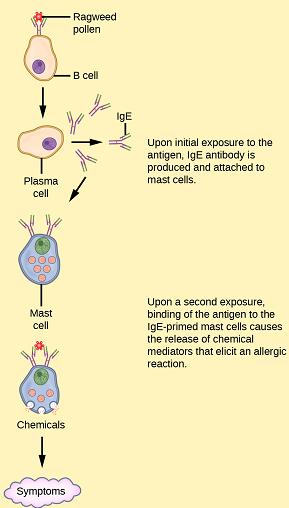Module 8: The Immune System
Section outline
-

The environment consists of numerous pathogens, which are agents, usually microorganisms, that can cause diseases. Pathogens include bacteria, protists, fungi and other infectious organisms. We are constantly exposed to pathogens in food and water, on surfaces, and in the air.
Components of the immune system constantly search the body for signs of pathogens. When pathogens are found, immune factors are mobilized to the site of an infection.
In this module, students will learn about the anatomy and physiology of the immune system. Features of the immune system that are essential for survival against pathogens, such as pathogen identification, specific response, amplification, retreat, and remembrance are explored.
The IgE molecules bind to mast cells, and on secondary exposure, the mast cells release histamines and other modulators that affect the symptoms of allergy.
Image from Biology 2e from OpenStax, licensed under Creative Commons Attribution License v4.0 with the image credit modification of work by NIH.
Upon completion of this module, you will be able to:
- Describe physical and chemical immune barriers
- Explain immediate and induced innate immune responses
- Discuss natural killer cells
- Describe major histocompatibility class I molecules
- Summarize how the proteins in a complement system function to destroy extracellular pathogens
- Explain adaptive immunity
- Compare and contrast adaptive and innate immunity
- Describe cell-mediated immune response and humoral immune response
- Describe immune tolerance
- Explain cross-reactivity
- Describe the structure and function of antibodies
- Discuss antibody production
- Describe hypersensitivity
- Define autoimmunity
To achieve these objectives:
- Read the Module 8 Introduction
- Read and view the materials in the Module 8 Pressbooks book
- Read Chapter 21 in the Module 8 Pressbooks book
- Complete the Module Assignment
- Complete the Module Discussion
- This module does not have a laboratory activity
You will find the following resources and activities in this module at the Pressbooks website. Click on the links below to access or complete each item.
Background Colour
Font Face
Font Kerning
Font Size
Image Visibility
Letter Spacing
Line Height
Link Highlight
Text Colour
